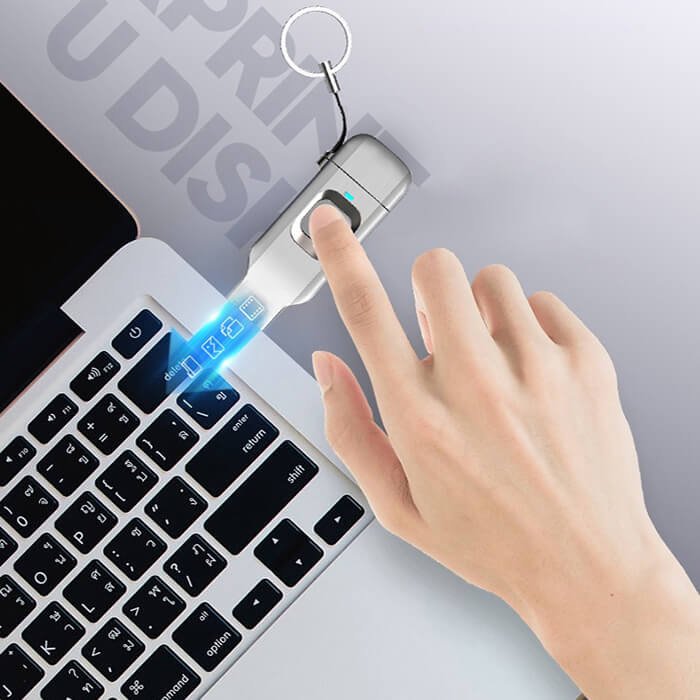The primary reason the actual capacity of a USB flash drive is smaller than the labeled capacity is that manufacturers and computer systems use different methods to calculate capacity. Manufacturers use the decimal system (1GB = 1000MB, 1MB = 1000KB) for capacity calculations, while computer systems recognize capacity based on the binary system (1GB = 1024MB, 1MB = 1024KB). When converting between these two systems, the actual displayed capacity will naturally be smaller than the labeled value. This is a normal technical discrepancy and not a product defect.
1、USB Drive Capacity Calculation Method:
(1) Manufacturer’s Decimal Calculation
USB manufacturers use the decimal system to label storage capacities. The core conversion rules are: 1GB = 1000MB, 1MB = 1000KB, 1KB = 1000B. This standard aligns with the storage industry’s common measurement practices, enabling users to intuitively understand the product’s nominal capacity range. It also serves as the unified specification for manufacturers when labeling capacities on USB drives, hard disks, and other storage devices.
Manufacturers use the decimal standard for capacity labeling as follows:
• 1GB = 1000MB
• 1MB = 1000KB
• 1KB = 1000B
For example, a 64GB USB drive has a total byte count calculated as: 64 × 1000 × 1000 × 1000 = 64,000,000,000 bytes.
(2) Binary Calculation in Operating Systems
The binary calculation method for USB drives is the standard used by computer systems to recognize storage capacity. Applicable scenarios: When operating systems like Windows or Mac read storage devices such as USB drives or hard disks, this is the default method for calculating actual available capacity. Computer systems recognize capacity according to binary standards, specifically:
• 1GB = 1024MB
• 1MB = 1024KB
•1KB = 1024B
Therefore, the actual capacity of a 64GB USB drive in the system is: 64,000,000,000 ÷ 1024 ÷ 1024 ÷ 1024 ≈ 59.6GB. This result closely matches the commonly observed scenario where “64GB shows 57GB” (remaining capacity may further decrease due to other factors).
USB Drive Decimal to Binary Conversion Parameter Comparison Table
| Comparison | Decimal Calculation | Binary Calculation |
|---|---|---|
| Conversion factor | In multiples of 1000 | 1024 is a multiple (2 to the power of 10) |
| Conversion relationship | 1GB=1000MB | 1GB=1024MB |
| 1MB=1000KB | 1MB=1024KB | |
| 1KB=1000B | 1KB=1024B | |
| Unit | Bety | Bety |
| scene | Storage Manufacturer Labeled USB Drive | Windows, Mac, and other systems recognize the actual usable capacity of the device. |
| Nominal capacity of hard drives and other devices |
Reference for Actual Usable Capacity of Commonly Rated Capacities
The following table provides reference values for capacity differences calculated using various methods. If the results fall within this range, it is considered normal and does not indicate a USB drive quality issue.
| Nominal capacity | Theoretical vs. Actual Capacity | System displays available capacity |
| 4GB | about 3.73GB | about 3.5-3.7GB |
| 8GB | about 7.45GB | about 7.0-7.3GB |
| 16GB | about 14.9GB | about 14.0-14.5GB |
| 32GB | about 29.8GB | about 28.0-29.0GB |
| 64GB | about 59.6GB | about 57.0-59.0GB |
| 128GB | about 119.2GB | about 115.0-118.0GB |
In addition to the differing calculation methods mentioned above, there are other factors that may contribute to minor discrepancies, though these factors account for only a small portion of the total:
(1) Space Occupied by System Files
When formatting a USB drive, partition tables (e.g., MBR/GPT) and file systems (e.g., FAT32/NTFS/exFAT) must be created. These structures occupy a portion of the storage space. For example:
- The FAT32 file system requires reserved space for the File Allocation Table (FAT) and root directory area, typically consuming several hundred KB to several MB of space;
- The NTFS system allocates space for log files, metadata areas, etc., occupying relatively more space.
(2) Pre-installed Software / Encryption Features
Some USB drives come with pre-installed programs like encryption tools or backup software, or include built-in secure partitions, all of which occupy a portion of the available capacity.
(3) Firmware and Hidden Partitions
The firmware embedded in the USB drive’s controller chip (responsible for data read/write and device recognition) occupies a small amount of physical capacity, typically tens to hundreds of MB. Some USB drives contain hidden partitions (e.g., areas for boot functions or firmware upgrades), which are inaccessible to users and also reduce usable capacity.
(4) Bad Blocks and Wear Leveling

Flash memory chips inevitably contain bad blocks (storage units that cannot be read or written normally) during manufacturing. Manufacturers mask these bad blocks during mass production, resulting in actual usable capacity being lower than the rated value.
Additionally, the USB drive’s “wear leveling” mechanism (which evenly distributes read/write cycles to extend lifespan) requires reserving space for data migration and mapping, accounting for approximately 2%-3% of total capacity. Before shipment, “bad blocks”—cells incapable of stable data storage—are detected and masked to prevent data loss. The greater the number of bad blocks, the more capacity they occupy.
It is normal for a USB drive to display a capacity lower than its labeled value. This is typically caused by a combination of technical specifications (calculation methods, file systems) and hardware design (manufacturer-reserved space, bad block handling). If the capacity discrepancy falls within a reasonable range (e.g., a 64GB drive showing 57-59GB, or a 128GB drive showing 119-121GB), this is a reasonable phenomenon due to calculation methods, file systems, and manufacturer-reserved space, and there is no need for concern.
If the displayed capacity falls below 80% of the theoretical value (e.g., 64GB showing < 50GB), or if the drive cannot store files matching its displayed capacity (e.g., showing 57GB but only storing 10GB), this may indicate a counterfeit drive or hardware failure.



